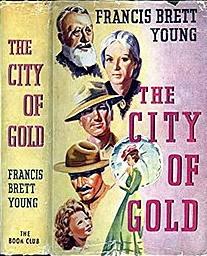
Book Review by Mary Grover: Having, years ago, read one of Young’s Mercian novels I was bamboozled, late at night, by the fact my copy of The City of Gold had front and end papers decorated with maps of the Severn valley and of the Midland counties in which most of Young’s novels are set. This led me to misread a sentence on the second page as ‘There were no lions near Wolverhampton, now, thank goodness, though in the year when their first house was built John had shot half a dozen’. Bemused and three pages on I realised, at midnight, that for Wolverhampton read Wonderfontein.
Despite the cosy Hobbit-land maps of Worcestershire at the front of the novel, the characters in this novel never go near the Midlands. They spend their lives in the Transvaal Republic during a tumultuous period in the late nineteenth century.
The City of Gold is Johannesburg during the 1870s and 80s when it is being transformed by the lust for precious metals into a large and violent city. The Grafton family at the heart of the story is torn apart by various forces: the hostility between those of Dutch and those of British ancestry; the values of traditional farmers and the materialism of those engaged in the mining and exploitation of minerals and the feminised graces of a settled civilization in conflict with the masculinised virtues of those defending such a civilization. The father, John, is English: a farmer struggling to make money out of breeding livestock. The mother, Lisbet, is a Boer but with French Huguenot ancestry: fecund and maternal. Throughout the book the genetic make-up of every character is used to account for their behaviours. An errant son, Andries is ‘fierce and turbulent’ because of the ‘Bezuidenhout strain in their race’, (one of many obscure references used to sketch the back story of the family which has figured in a previous novel, They Seek a Country 1937.) The protagonist of the novel is the sensitive and disabled son, Janse, whose intellectual nature draws his mother towards him and leads her to conclude that he has more of her French Huguenot blood than her other sons who are rougher: farmers, diamond transporters and men of action.
Then of course, there is the black population of South Africa. Hottentot and Kaffirs initially have walk on parts as silent or surly servants but the Zulus figure in the final part of the book as brutal and ruthless. The events of the British and Zulu war dominate the action. There is a complete denial of the racial complexities of the relationships between European and African. Oh these ‘endless Kaffir wars’ reflects Lisbet vaguely. Instead the focus is on the contradictions and complexities of the relationships between different kinds of European, perhaps a reflection of the date when the novel was written, 1939, when Anglo-Saxon races were about to enter into a deadly conflict with each other.
David Cannadine argues that by the end of the 1930s Young’s nostalgia for the notional stability of a rural and hierarchical society had lost its power to attract readers.i Young’s friend and admirer, his Worcestershire neighbor Prime Minister Stanley Baldwin. shared his vision of a stability that predated the First World War and could be recaptured. Both Baldwin and Young, by 1939 had lost their political or popular appeal. This novel is perhaps an attempt by Young to articulate the tragedy of modern Europe in an African setting and to reassert a connection with a public which more and more were turning towards the historical novel and to factual histories to help them understand the approaching catastrophe. One of his most awkward sentences of the book comes at the beginning when the slightly built, Lisbet, wonders how her little womb could have produced such thumping great sons most in opposition with each other. Her bemusement is perhaps matched by Young’s inability to imagine how the Anglo-Saxon race has turned upon itself. The clunkiness of the opening pages is with its gobbits of the history of far-away places is, I would have thought, uncharacteristic of Young, who later in the book sets up a cracking pace in his narrative. The clumsy exposition at the beginning of the novel suggests the problems of setting a narrative in a place and time unfamiliar to his usual readership. Though the historical novel is often a convenient medium for popular authors to explore current themes in code, as Mary Renault did with her novels about same sex sexuality in archaic Greece, the context of the South African conflicts require far too much exposition to make this an easy read for a readership who would have come to look to Young for a reassurance that English values were still accessible in the English provinces. I wonder what his habitual readers made of these introductory sentences with endless subclauses, mysterious place-names and unfamiliar histories. This may have been a book designed to demonstrate that Young was up-to-the-minute but I fear that its 500 pages will not have had the power to distract readers from the problems of the present or to help readers understand how they might have arisen.
I must confess that my reading of the novel was sketchy as I found it difficult to read. I would welcome any corrections to my reading of it.
i David Cannadine 2004. In Churchill’s Shadow: Confronting the Past in Modern, Chapter 7 ‘Emollience: Stanley Baldwin and Francis Brett Young’.
